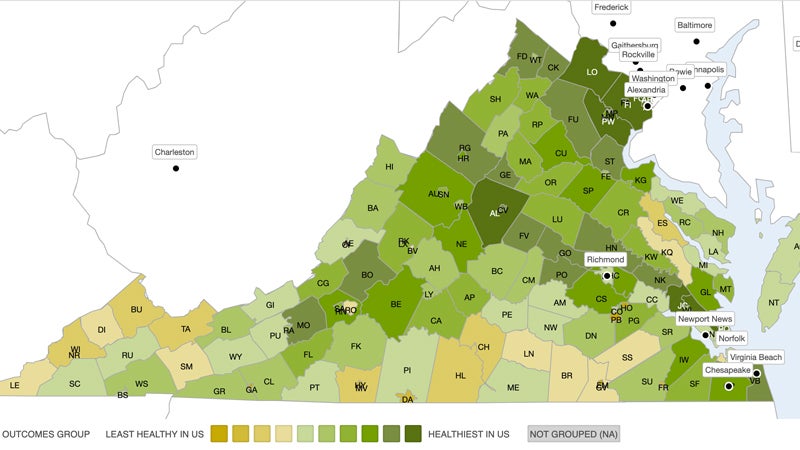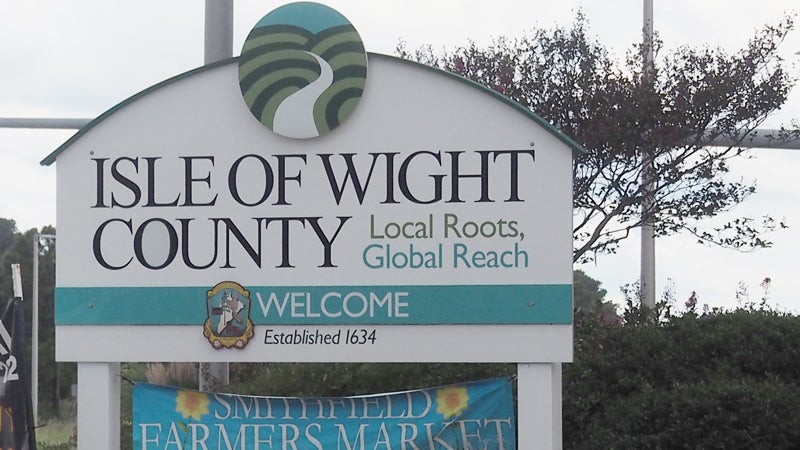IW ranks 40th in life expectancy among Virginia localities
Published 6:14 pm Friday, March 29, 2024

- The University of Wisconsin has released a map showing the most and least healthiest counties in Virginia. (Image courtesy of University of Wisconsin)
Deaths under age 75 are robbing Isle of Wight County residents of an estimated 7,600 years of life per 100,000 people.
That’s according to the latest health rankings the University of Wisconsin’s Population Health Institute released this month. The study aims to achieve a nationwide county-by-county comparison that accounts for the vastly differing lifestyles and population densities between rural and urban localities.
Isle of Wight, which had just over 40,000 residents as of mid-2023 according to census estimates, is just under par with the nation but below the state average in terms of premature deaths. According to the report, Virginians who die before age 75 are losing 7,300 years per 100,000 residents while the nationwide average is 8,000 years.
Meanwhile, sparsely populated Surry County’s 6,500 residents are faring somewhat worse, with 8,800 years lost per 100,000.
A disaggregation of Isle of Wight’s 7,600 estimate shows premature deaths are nearly twice as common among Black residents, with the county’s African American population losing a collective 12,000 years of life per 100,000 compared to only 6,400 years per 100,000 for white residents. Black residents account for just under 23% of the county’s populace, according to census estimates.
A disaggregation by race of Surry’s 8,800 wasn’t included in the 2024 reports, though results from 2021 showed a similar disparity, with 14,400 years lost per 100,000 for Black residents compared to 8,700 for the county’s white population.
Average life expectancy in Isle of Wight stands at 77.8 years, putting it in 40th place among Virginia’s 133 cities and counties. Surry is trailing in 52nd place at 76.8 years.
The top five cities and counties with the highest life expectancy, ranging from 82.5 to 85.3 years, are all in Northern Virginia. The city of Franklin, which borders Isle of Wight to the south, is in the bottom five at 67.9.
Past reports show cancer as the leading cause of premature deaths in Isle of Wight and Surry since at least 2013. According to the data, there were 151 cancer-related deaths under age 75 in Isle of Wight, or 143.7 per 100,000, from 2019 to 2021, the years on which the 2024 report is based. Surry saw 30 cancer-related under-75 deaths during the same two years, or 171.5 per 100,000.
Heart disease and accidents were in second and third place, respectively, for both counties.
In fourth place in Isle of Wight – but not Surry – is COVID-19, which accounted for 41 under-75 deaths, or 39 per 100,000, from 2019 to 2021. According to data from Johns Hopkins University, Isle of Wight saw over 120 coronavirus-linked deaths from the start of the 2020 pandemic through March 9, 2023, the day before Johns Hopkins stopped updating its county-level dashboard.
Virginia as a whole saw 150.5 cancer-related deaths per 100,000 among all age groups in 2021, according to U.S. Centers for Disease Control data. It’s the second leading cause of death statewide behind heart disease, the prevalence of which stood at 167.2 deaths per 100,000 among all age groups as of 2021.
The report examines not only health outcomes but their contributing factors, such as the availability of medical care, percentage of children born into poverty, and even voter turnout.
“The healthiest counties, where people live long and well, have well-resourced civic infrastructure, including a more accessible information environment (local news outlets, broadband access and public libraries), compared to counties among the least healthy,” the 2024 report states. “Counties with well-resourced civic infrastructure and accessible information environments also offer more social and economic opportunity for good health. In these counties people have higher rates of participation, such as voting or union membership, and people tend to live longer.”
Isle of Wight, at one primary care physician per 2,450 residents, has nearly half as many as the state’s one-in-1,340 ratio. Surry, at one in 6,530 residents, has more than four times as few.
Isle of Wight is also well below the state’s one-in-410 ratio of mental health practitioners to residents, at one in 1,910. Surry has one per 1,630 residents. Suicide, or “intentional self harm” as its referred to in the report, accounted for 16 Isle of Wight deaths under age 75 from 2018 through 2020.
Currently, neither Isle of Wight nor Surry has its own hospital, though the 50-bed Riverside Smithfield Hospital, which is intended to serve both counties, is under construction and expected to open in early 2025.
Smithfield Vice Mayor Valerie Butler, who also serves on the hospital’s regional medical board, said she recalled a discussion at the hospital’s 2021 state certificate of public need hearings with former Virginia Chief Diversity Officer Janice Underwood regarding the disparity in mortality rates between rural and urban Virginia, particularly in the state’s African American population.
“Some of those factors are inadequate access to health care, socio-economic factors, lack of transportation, lack of insurance coverage and environment,” Butler said. “Hopefully the Riverside/Smithfield Hospital will resolve some of the access problems.”
According to the town of Smithfield’s 2022-adopted comprehensive plan, 9.2% of white residents and 31% of Black residents were living below the poverty line, compared to statewide poverty rates of 7.9% for whites and 16.4% for African Americans, as of that year. According to census data, Smithfield and Isle of Wight saw overall poverty rates of 12.3% and 8.5% in 2022, respectively.
Editor’s note: This story has been updated with remarks by Valerie Butler.





